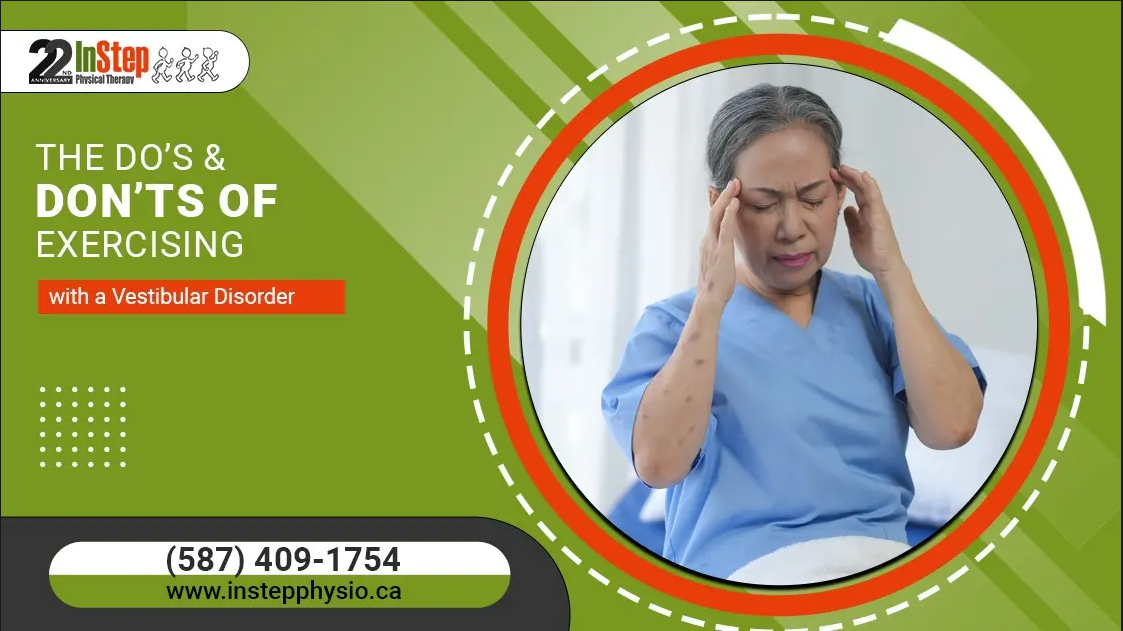Exercising with a vestibular disorder can feel overwhelming. Dizziness, imbalance, and nausea can make movement challenging, leaving many unsure of how to stay active safely. However, the right approach to exercise can help improve stability, reduce symptoms, and support overall well-being. Vestibular physiotherapy in Edmonton focuses on managing these conditions through targeted movements that enhance balance and coordination.
Understanding what to do—and what to avoid—when exercising with an inner ear disorder is key to preventing worsening symptoms while promoting recovery. Identifying which exercises provide benefits and which may lead to discomfort is crucial for maintaining stability and enhancing function.
Understanding Vestibular Disorders and Exercise
A vestibular disorder affects the inner ear and the brain’s ability to process balance signals. Common conditions include:
- Benign Paroxysmal Positional Vertigo (BPPV) – Caused by displaced calcium particles in the inner ear, leading to short but intense vertigo episodes.
- Meniere’s Disease – A disorder involving fluid buildup in the inner ear, causing dizziness, ringing sensations in the ears, and hearing loss.
- Vestibular Neuritis/Labyrinthitis – Inflammation affecting the vestibular nerve, resulting in vertigo and balance disturbances.
Regular exercise can help with vestibular rehabilitation by improving coordination and strengthening muscles that support balance. However, certain movements may trigger dizziness or worsen symptoms, making it important to follow proper guidelines.
The Do’s of Exercising with a Vestibular Disorder
1. Start with Vestibular Physiotherapy
Before beginning any exercise routine, vestibular physiotherapy in Edmonton can provide a structured plan tailored to individual needs. A trained therapist can assess symptoms, identify triggers, and recommend exercises that promote gradual adaptation to movement.
2. Focus on Slow, Controlled Movements
Abrupt or jerky movements can worsen dizziness. Instead, prioritize slow, deliberate exercises such as:
- Gentle head turns and nods.
- Controlled balance exercises.
- Walking in a straight line with a focused vision.
3. Incorporate Balance Training
Balance exercises help strengthen stability and reduce reliance on vision for orientation. Recommended exercises include:
- Standing on one leg (with support if needed).
- Walking heel-to-toe along a straight path.
- Use a balance board or stability cushion.
4. Practice Gaze Stabilization Exercises
Since inner ear balance issues often affect vision, gaze stabilization exercises help improve coordination. A common technique includes:
- Fixating on a stationary object while slowly moving the head from side to side.
- Increasing speed and duration as tolerance improves.
5. Stay Hydrated and Take Breaks
Dehydration can exacerbate dizziness. Regular water intake and short rest periods between exercises can prevent excessive fatigue.
6. Engage in Low-Impact Activities
High-impact workouts can be overwhelming, but low-impact activities can provide benefits without triggering symptoms. Recommended options include:
- Pilates – Focuses on core strength and stability with slow, controlled movements.
- Stationary cycling with controlled head movement.
- Walking on a treadmill at a consistent speed.
The Don’ts of Exercising with a Vestibular Disorder
1. Avoid Rapid Head Movements
Sudden changes in head position can trigger dizziness or vertigo. It’s essential to avoid:
- Fast head turns or quick direction changes.
- High-intensity interval training (HIIT) involves rapid motion.
- Activities that require frequent looking up or down.
2. Don’t Push Through Severe Dizziness
Mild discomfort during vestibular rehabilitation is expected as the body adapts, but severe dizziness should not be ignored. If symptoms become intense, stop exercising and rest.
3. Avoid High-Risk Activities
Certain exercises can increase fall risk. Activities to avoid include:
- Running on uneven surfaces.
- Jumping exercises (e.g., jumping jacks or burpees).
- Sports with rapid head movement, like tennis or basketball.
4. Don’t Rely Solely on Vision for Balance
Many people with inner ear disorders unknowingly depend on their vision to maintain balance. While this may seem helpful, it can reinforce instability when visual input is removed. Training the body to balance using proprioception (body awareness) is essential.
5. Skip Overexertion and Sudden Postural Changes
Fatigue can worsen inner ear balance issues, making symptoms more pronounced. Additionally, sudden changes in posture—such as quickly standing up—can cause dizziness. Gradually transitioning between positions is advised.
6. Avoid Excessive Screen Time Immediately After Exercise
Visual stimuli from screens (phones, computers, or TVs) can aggravate dizziness post-exercise. Allow time for the body to adjust before engaging in screen-based activities.
How Vestibular Therapy Supports Safe Exercise
Vestibular therapy in Edmonton focuses on retraining the brain’s ability to process balance signals. A structured vestibular rehabilitation program can:
- Reduce dizziness by improving coordination and stability.
- Help the body adapt to movement through gradual exposure to balance exercises.
- Strengthen muscles that assist with posture and head control.
Individuals experiencing persistent symptoms may benefit from professional guidance. Physiotherapy clinics provide tailored vestibular treatment plans to help restore balance and confidence in movement.
Making Exercise a Safe Part of Recovery
Physical activity plays a vast role in maintaining health, but exercising with a vestibular disorder requires adjustments. Choosing appropriate exercises, maintaining balance, and avoiding symptom-triggering movements can make workouts safer and more effective. Seeking guidance from professionals specializing in vestibular rehabilitation ensures that exercise routines support recovery rather than aggravate symptoms.
For those seeking professional support, In Step Physical Therapy offers personalized dizziness treatment and vestibular rehabilitation programs. Incorporating vestibular physiotherapy in Edmonton into a recovery plan can provide long-term improvements in balance, coordination, and overall quality of life.
Keywords: Vestibular disorder, vestibular rehabilitation, vestibular therapy, inner ear disorder, inner ear balance issues, Vestibular physiotherapy Edmonton, dizziness treatment, In Step Physical Therapy Edmonton.



